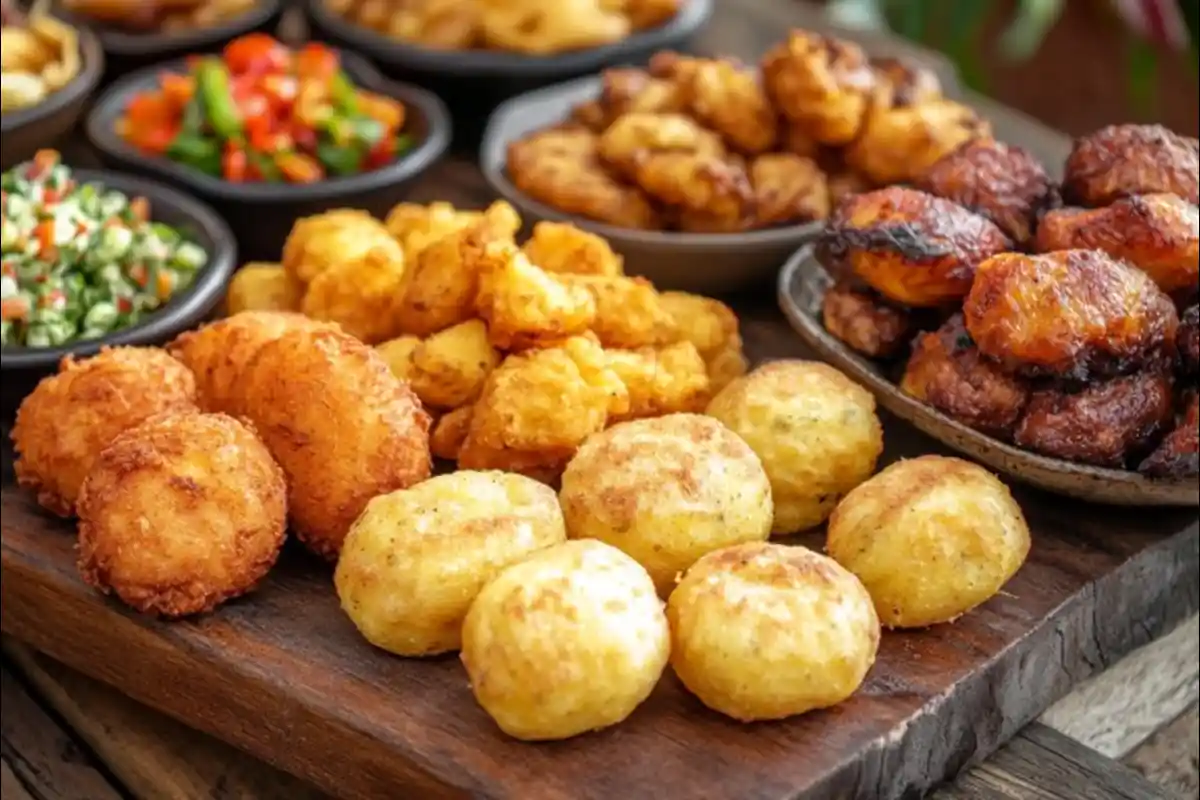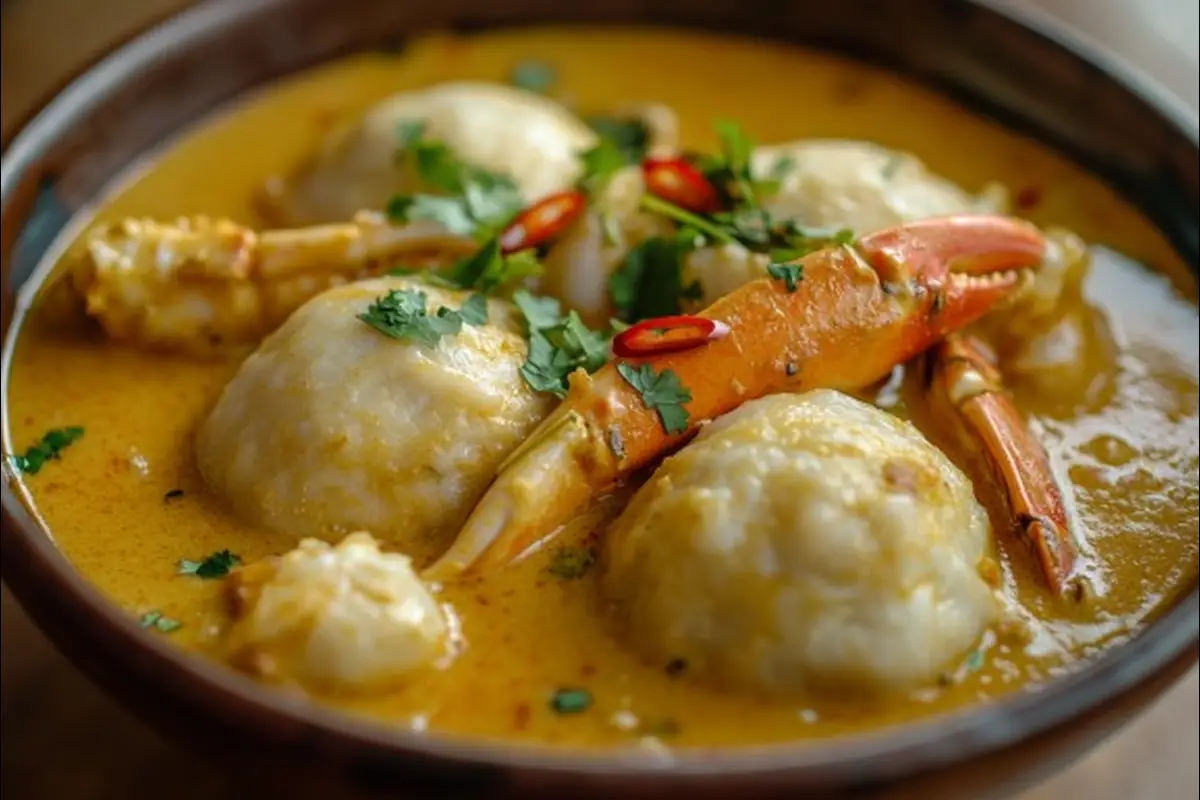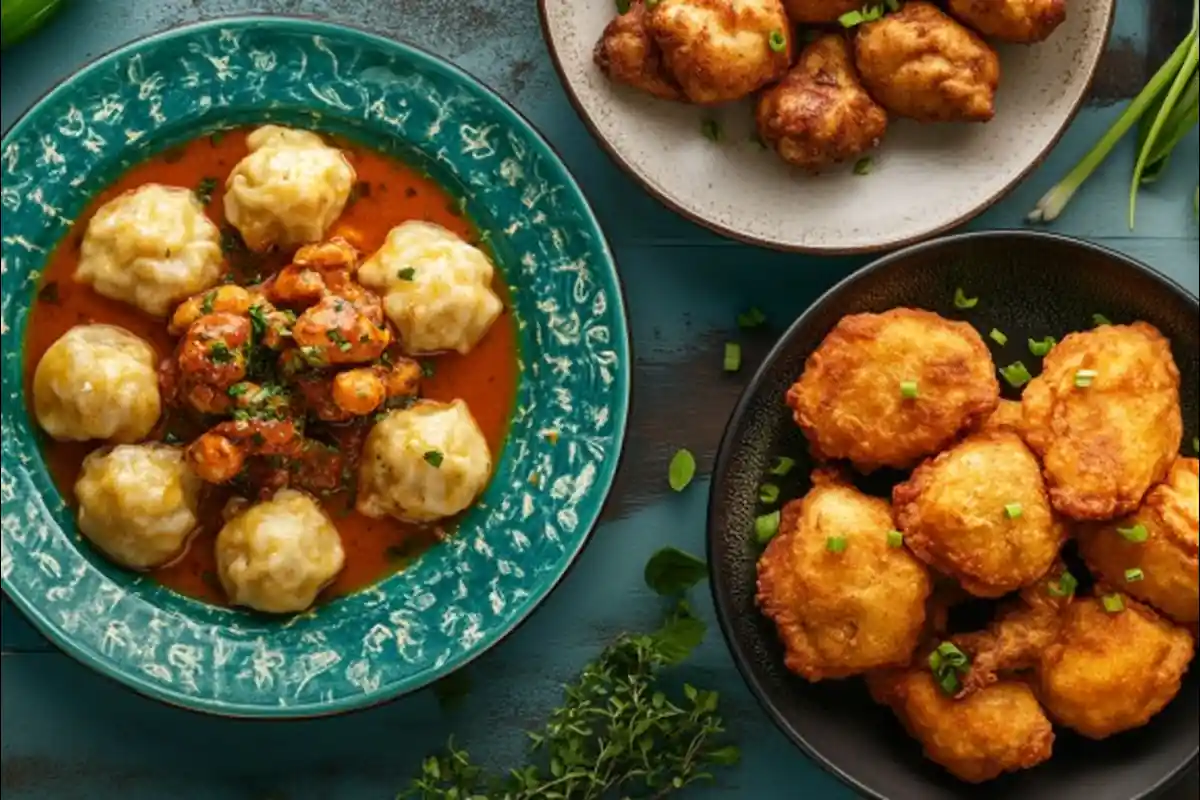1: Introduction
Dumplings are an essential part of Caribbean cuisine, offering a hearty addition to meals while carrying deep cultural significance. But how do Trinidad dumplings differ from Jamaican dumplings? This question highlights the diverse culinary traditions of these two islands, where dumplings vary in ingredients, textures, and cooking methods.
Caribbean dumplings share some similarities, like their flour-based origins. However, the differences in ingredients, cooking methods, and textures showcase the diversity between Jamaica and Trinidad’s culinary practices. Additionally, their cultural significance varies, as these dumplings often appear in different traditional dishes.
This article will explain the specific differences between Trinidadian and Jamaican dumplings. From cassava-based Trinidadian dumplings to Jamaica’s fried and festival versions, we’ll dive deep into their preparation techniques, flavors, and cultural roles. You’ll also discover how they pair with popular dishes like ackee and saltfish and curry crab.
If you’ve ever wondered which dumpling you should try first, stay tuned. By the end, you’ll have all the knowledge you need to appreciate both—and maybe even try some recipes yourself!
2. What Are Caribbean Dumplings?
Caribbean dumplings are a beloved staple, but how do Trinidad dumplings differ from Jamaican dumplings? While both share a common foundation, the differences in their preparation reflect the unique flavors and techniques of each island. Furthermore, people enjoy these humble yet versatile dough creations in various forms, whether boiled, fried, or sweetened. Ultimately, they provide a delicious and satisfying addition to any meal. Despite their straightforward nature, dumplings serve as a foundation for countless meals and hold cultural significance.
2.1 A Brief Definition of Caribbean Dumplings
At their core, dumplings are made with just a few simple ingredients:
- Flour (most commonly all-purpose flour)
- Water or coconut milk
- A pinch of salt
The dough undergoes kneading, shaping, and cooking in different ways depending on the country and dish. While basic in preparation, these dumplings adapt to local tastes.
In Jamaica, cooks often fry dumplings to a golden crisp, creating a satisfying crunch, or boil them to perfectly complement rich dishes like ackee and saltfish. Meanwhile, sweet festival dumplings offer a delightful twist as they include sugar and a hint of cornmeal, which adds a subtle sweetness and grainy texture.
Meanwhile, Trinidad showcases dumplings that are often softer and more pliable. Variations include using cassava flour, yams, or other ground provisions to create dumplings that absorb savory, saucy flavors—perfect for dishes like curry crab.
2.2 Why Are Dumplings So Important in Caribbean Cuisine?
Dumplings reflect the soul of Caribbean cooking: resourceful, flavorful, and comforting. Across the islands, they symbolize family, community, and tradition. Dumplings appear on everyday dinner tables as well as during festive gatherings and celebrations.
2.2.1 Versatile and Hearty Staple
Caribbean dumplings provide a hearty addition to meals, making dishes filling and nutritious. Their neutral taste allows them to complement bold flavors in Caribbean cuisine, such as jerk spices, coconut-based curries, and stews.
2.2.2 A Cultural Symbol
For many families, dumplings are more than food—they are tradition. Whether boiled in soups or fried as snacks, dumplings tie generations together. Recipes often pass through generations, with small tweaks that make them unique to each household.
In Jamaica, people commonly serve dumplings during breakfast with ackee and saltfish or in hearty soups. On the other hand, Trinidadians often serve dumplings with saucy curries like curry crab, where the dough absorbs all the rich, aromatic spices.
2.3 Key Similarities Across Caribbean Dumplings
Before fully answering how do Trinidad dumplings differ from Jamaican dumplings, let’s examine their similarities. Both variations share common elements that make them integral to Caribbean cuisine:
- Both use flour-based dough as a base.
- Dumplings are boiled or fried, showcasing versatility in cooking methods.
- They are seen as hearty staples, often paired with stews, curries, and soups.
Despite these shared traits, each island adds its unique spin, resulting in exciting differences in taste, texture, and preparation methods.
Ingredients: How Trinidad Dumplings Differ from Jamaican Dumplings
The first step in answering how do Trinidad dumplings differ from Jamaican dumplings is understanding the key differences in their ingredients. While both start with a basic dough, their variations reflect the culinary traditions of each island. While both start with a basic dough, the additions and variations used in each reflect the unique culinary traditions of their respective islands.
3.1 Jamaican Dumplings: A Focus on Simplicity and Sweetness
Jamaican dumplings feature simple ingredients that come together to create firm and versatile dough. The two most common types of Jamaican dumplings are:
3.1.1 Boiled Jamaican Dumplings
- Made with all-purpose flour, water, and a pinch of salt.
- Sometimes a small amount of cornmeal is added to enhance texture.
- These dumplings are dense, chewy, and perfect for soaking up flavorful stews or soups.
3.1.2 Festival Dumplings: A Sweet Twist
Festival dumplings are a popular variation in Jamaica, especially as a snack or street food. Their key ingredients include:
- All-purpose flour
- Cornmeal for a slightly grainy texture
- Sugar for sweetness
- A touch of baking powder to create a light, fluffy interior
Cooks fry festival dumplings to golden perfection and often pair them with dishes like jerk chicken or fried fish. The addition of sugar makes them unique compared to traditional dumplings from other Caribbean regions.
3.2 Trinidadian Dumplings: Embracing Variety and Ground Provisions
In Trinidad, dumpling recipes are not only more diverse but also rich in tradition. For example, Trinidadians often incorporate local root vegetables and starchy ingredients known as ground provisions. As a result, this adds variety to the dumplings’ flavor, texture, and nutritional content, making them both unique and nutritious.
3.2.1 Classic Boiled Dumplings
- Traditionally made with all-purpose flour, salt, and water.
- These dumplings are soft and pliable, ideal for pairing with saucy dishes like curry crab.
3.2.2 Cassava Dumplings
Cassava dumplings are a gluten-free option that showcases Trinidad’s creative use of local produce. Ingredients include:
- Cassava flour (made from ground cassava root)
- A small amount of water and salt to bind the dough
These dumplings are lighter and have a slightly earthy flavor that complements rich and savory curries.
3.2.3 Yam or Ground Provision Dumplings
Trinidadian dumplings sometimes include yam, dasheen, or other root vegetables. Cooks boil, mash, and mix these ingredients into the dough to create a unique texture. The result is a dumpling that is softer and slightly sweet, with a distinct Caribbean flair.
3.3 Comparing Ingredients: Jamaican vs Trinidadian Dumplings
The table below highlights the key differences in ingredients between Jamaican and Trinidadian dumplings:
| Feature | Jamaican Dumplings | Trinidadian Dumplings |
|---|---|---|
| Main Ingredients | Flour, cornmeal, sugar (festival) | Flour, cassava flour, ground provisions |
| Sweet Variations | Festival dumplings (sugar, cornmeal) | Rarely sweetened |
| Ground Provisions | Not typically used | Commonly include yam, cassava, dasheen |
| Texture Impact | Firm and dense | Soft, pliable, and absorbs flavors |
3.4 Why Do Ingredients Matter?
The choice of ingredients affects not only the texture but also the flavor and purpose of the dumplings:
- Jamaican dumplings are dense and hearty, making them ideal for robust dishes like jerk chicken, ackee and saltfish, or soups.
- Trinidadian dumplings, on the other hand, are soft and pliable, designed to soak up flavorful sauces in dishes like curry crab or oxtail stew.
Additionally, the use of cassava and ground provisions in Trinidadian dumplings reflects the island’s agricultural heritage and commitment to using local, fresh ingredients. Meanwhile, Jamaica’s sweet festival dumplings are perfect for balancing the spiciness of jerk dishes.
Cooking Methods: Trinidadian Dumplings vs Jamaican Dumplings
One of the most noticeable differences between Trinidadian and Jamaican dumplings lies in their cooking methods. While both share similarities, their preparation techniques emphasize distinct culinary traditions and flavors.
4.1 Jamaican Dumplings: Boiled, Fried, and Sweetened

Jamaican dumplings are incredibly versatile. They boil, fry, or sweeten the dumplings depending on the dish they accompany.
4.1.1 Boiled Dumplings
Boiled dumplings are the most traditional in Jamaica. They often accompany hearty meals, such as ackee and saltfish or rich stews.
- The dough uses flour, water, and a touch of salt, and cooks shape it into discs or balls.
- These dumplings are then boiled in salted water until they become firm and chewy.
- The dense texture makes them perfect for soaking up gravies and sauces.
4.1.2 Fried Dumplings
Fried dumplings are a staple in Jamaican cuisine, particularly as a breakfast or snack option. Known as Johnny cakes, they are golden and crispy on the outside, with a fluffy interior.
- Dough is prepared with flour, baking powder, salt, and water.
- The dumplings are shaped into small rounds and deep-fried in oil until golden brown.
- Fried dumplings are often paired with callaloo, saltfish, or served as standalone treats.
4.1.3 Festival Dumplings
Festival dumplings offer a sweet variation of Jamaican fried dumplings. The dough includes sugar and cornmeal, which creates a slightly sweet, grainy texture.
- Cooks deep-fry festival dumplings until they turn crispy on the outside and soft on the inside.
- They are a favorite pairing for dishes like jerk chicken or fried fish. In fact, the sweetness perfectly balances the bold, spicy flavors of these dishes, creating a harmonious contrast that enhances the overall dining experience.
4.2 Trinidadian Dumplings: Predominantly Boiled with Saucy Dishes
In Trinidad, people usually boil dumplings, showcasing the island’s love for rich, saucy meals.

4.2.1 Boiled Dumplings
Boiled dumplings in Trinidad are soft and pliable, making them ideal for soaking up the bold, spicy flavors of Trinidadian curries and stews.
- The dough uses flour, water, and salt, sometimes combined with cassava flour or ground provisions to add flavor and texture.
- Shaped into flattened discs or oval shapes, they are gently boiled in salted water until tender.
4.2.2 Dumplings in Curries and Stews
Trinidadian dumplings play a starring role in dishes like curry crab and dumplings. The dumplings often boil directly in the curry sauce or absorb the dish’s rich, aromatic flavors when added after cooking.
4.2.3 Less Common: Fried Dumplings
Trinidadians occasionally fry their dumplings, but they rarely use this method compared to Jamaica. Fried variations may appear as small snacks but do not hold the same cultural prominence as boiled dumplings.
4.3 Comparing Cooking Methods
The table below summarizes the key differences in how Jamaican and Trinidadian dumplings are prepared:
| Cooking Method | Jamaican Dumplings | Trinidadian Dumplings |
|---|---|---|
| Boiled | Firm and chewy, often paired with stews or soups | Soft and tender, ideal for soaking up curries |
| Fried | Crispy on the outside, fluffy inside | Less common, but occasionally served as snacks |
| Sweetened (Festival) | Made with sugar and cornmeal; deep-fried | Rarely sweetened |
| In Curries/Stews | Added to soups like red peas soup | Cooked directly in curries like curry crab |
4.4 Why Cooking Methods Matter
The cooking methods for dumplings directly influence their texture, taste, and purpose in a meal:
- Jamaican dumplings are versatile, served boiled with savory dishes, fried as snacks, or sweetened for a treat.
- Trinidadian dumplings prioritize boiled preparations, as their softer texture complements Trinidad’s saucy and flavorful curries.
Additionally, fried festival dumplings add sweetness to balance out Jamaica’s spicier meals, while Trinidadian dumplings embrace a more neutral flavor to blend seamlessly into stews and curries.
4.5 Cultural Preferences in Cooking Techniques
The differences in cooking methods reflect the culinary preferences of each island:
- In Jamaica, fried dumplings and festival dumplings are common as snacks and street food, showcasing the island’s love for bold, crispy textures.
- In Trinidad, boiled dumplings symbolize comfort and tradition, particularly in dishes that are steeped in flavorful sauces.
This cultural distinction clearly highlights how dumplings adapt to local tastes and cooking traditions. Furthermore, it emphasizes their versatility, making them essential to each island’s unique food identity. As a result, dumplings serve as both a unifying and defining element of Caribbean cuisine.
Texture and Flavor: How Trinidad Dumplings Differ from Jamaican Dumplings
The texture and flavor of dumplings are significant factors that distinguish Trinidadian dumplings from Jamaican dumplings. Although both share a foundation of flour and water, the way they are prepared and their additional ingredients give each version its unique appeal.
5.1 Jamaican Dumplings: Dense and Versatile
Jamaican dumplings tend to have a dense, firm, and chewy texture, making them a filling and hearty addition to meals.
5.1.1 Boiled Dumplings
- Boiled dumplings in Jamaica are thick and firm. The dense consistency makes them perfect for soaking up gravies or broths.
- They are served as part of ackee and saltfish, hearty soups, and stews where their sturdiness complements bold, savory flavors.
5.1.2 Fried Dumplings
- Fried dumplings, including Johnny cakes, are golden-brown and crispy on the outside but remain soft and fluffy on the inside.
- This texture contrast makes fried dumplings a popular snack or breakfast item, especially when paired with dishes like callaloo or saltfish.
5.1.3 Festival Dumplings
- Festival dumplings are slightly sweet and have a lighter, fluffier texture compared to traditional fried dumplings.
- The addition of sugar and cornmeal creates a grainy, yet tender bite, which pairs exceptionally well with spicy dishes like jerk chicken.
5.2 Trinidadian Dumplings: Soft and Absorbent
In contrast to the dense texture of Jamaican dumplings, Trinidadian dumplings are typically softer and more pliable. Their primary purpose is to absorb the flavors of the dishes they accompany.
5.2.1 Boiled Dumplings
- Trinidadian boiled dumplings have a soft and tender texture. The dough often includes cassava flour or mashed ground provisions, which make the dumplings light and slightly elastic.
- Their softness allows them to soak up sauces in dishes like curry crab and dumplings, enhancing their flavor.
5.2.2 Ground Provision Dumplings
- Adding yams, dasheen, or cassava to the dough results in a more textured and slightly earthy flavor. These dumplings are softer and offer a subtle sweetness, which pairs well with rich, coconut-based stews and curries.
5.2.3 Texture in Curries
- In Trinidad, dumplings are often added directly to curries or stews, where they simmer slowly and absorb the dish’s bold spices. As a result, this method creates dumplings that are incredibly flavorful and moist, practically melting in your mouth.
5.3 Comparing Textures and Flavors
The table below highlights the primary differences in texture and flavor between Jamaican and Trinidadian dumplings:
| Feature | Jamaican Dumplings | Trinidadian Dumplings |
|---|---|---|
| Texture | Dense, firm, chewy | Soft, pliable, and absorbent |
| Flavor | Neutral with slight saltiness; sweet in festivals | Light, neutral, sometimes earthy |
| Cooking Impact | Fried versions are crisp and fluffy inside | Boiled versions soak up rich sauces |
| Best Pairings | Savory dishes like ackee and saltfish, jerk chicken | Saucy dishes like curry crab and oxtail stew |
5.4 Why Texture Matters
The texture of dumplings determines how they interact with other foods:
- Jamaican dumplings, with their firmness, act as a sturdy complement to soups, stews, and fried dishes. They stand on their own as a filling component of the meal.
- Trinidadian dumplings, being softer and more absorbent, play a supporting role. They soak up flavorful curries and sauces, enhancing the overall eating experience.
Additionally, the sweetness of Jamaican festival dumplings contrasts beautifully with spicy dishes, balancing bold and fiery flavors. In Trinidad, the neutral, earthy flavors of cassava and yam dumplings highlight the richness of coconut and curry-based recipes.
5.5 Culinary Significance of Texture and Flavor
The differences in texture and flavor reflect the islands’ broader culinary preferences:
- In Jamaica, where bold, spicy flavors dominate, dumplings often act as a neutral or sweetened base to balance intense dishes. Fried dumplings also provide a crispy, satisfying texture as snacks or breakfast foods.
- In Trinidad, where stews and curries are rich and saucy, dumplings serve as flavor carriers. Their soft, tender texture makes them perfect for absorbing spices and sauces.
These distinctions not only highlight regional preferences but also demonstrate how dumplings adapt to the diverse flavors and cooking techniques of the Caribbean.
6. Regional Variations and Unique Recipes
Dumplings in the Caribbean are not a one-size-fits-all dish. While both Trinidadian and Jamaican dumplings share common elements, each island offers regional variations that showcase local flavors, traditions, and creativity.
6.1 Trinidadian Dumplings: Creative Use of Ground Provisions
In Trinidad, dumplings reflect the island’s agricultural roots. The use of ground provisions—local starchy vegetables such as cassava, yam, and dasheen—adds variety to their dumplings.
6.1.1 Classic Trinidad Boiled Dumplings
- These dumplings are simple yet versatile, made with all-purpose flour, salt, and water.
- They are often served with saucy dishes like curry crab and dumplings, where the dumplings soak up the curry’s rich, aromatic spices.
6.1.2 Cassava Dumplings
- Cassava dumplings use cassava flour, a gluten-free alternative, which gives the dumplings a light and slightly earthy flavor.
- These dumplings are popular in Trinidad for their health benefits and ability to complement hearty dishes.
- Recipe Tip: Serve cassava dumplings with coconut-based fish stew for a nutritious and flavorful meal.
6.1.3 Stew Dumplings
- Stew dumplings are often cooked directly in thick meat or vegetable stews.
- This method allows the dumplings to absorb the stew’s flavors, creating a soft, savory, and satisfying addition to the dish.
6.2 Jamaican Dumplings: Sweet, Savory, and Crispy Variations
Jamaican dumplings are celebrated for their versatility. Each type of dumpling pairs perfectly with specific meals or stands alone as a snack.
6.2.1 Johnny Cakes (Fried Dumplings)
- Johnny cakes are a staple of Jamaican breakfasts and snacks.
- Made with flour, baking powder, salt, and water, the dough is shaped into rounds and fried until golden brown.
- They are crispy on the outside and fluffy on the inside, making them ideal for pairing with callaloo, saltfish, or scrambled eggs.
6.2.2 Festival Dumplings
- Festival dumplings are Jamaica’s sweet fried dumplings. The addition of cornmeal and sugar gives them a sweet, slightly grainy texture.
- These dumplings are often served with jerk meats, like jerk chicken or jerk pork, providing a sweet balance to the spicy heat of the main dish.
6.2.3 Spinners
- Spinners are thin, elongated dumplings commonly used in soups and stews, such as red peas soup or chicken soup.
- They are denser and designed to hold their shape while simmering in hot broths.
- Spinners add heartiness to soups, turning them into satisfying, complete meals.
7. Frequently Asked Questions (FAQs)
What are Caribbean dumplings made of?
Caribbean dumplings are typically made with all-purpose flour, water, and salt. In Jamaica, cornmeal and sugar are sometimes added, especially for festival dumplings. Trinidadian dumplings may include cassava flour, yam, or other ground provisions to add flavor and variety.
Where did Jamaican dumplings originate from?
Jamaican dumplings trace their origins to African and European influences brought to the Caribbean during the colonial period. The combination of simple, affordable ingredients made dumplings a staple food, providing sustenance and versatility for Jamaican households.
Are there different kinds of dumplings?
Yes, Caribbean dumplings come in many variations. In Jamaica, there are boiled dumplings, fried dumplings (Johnny cakes), and festival dumplings (sweetened, fried). Trinidad features cassava dumplings, boiled dumplings, and dumplings made with yams or ground provisions.
What are Jamaican fried dumplings made of?
Jamaican fried dumplings, also known as Johnny cakes, are made with flour, baking powder, salt, and water. The dough is shaped into small rounds and fried until golden brown. Festival dumplings, a sweeter version, include cornmeal and sugar for added flavor.
What are Trinidadian cassava dumplings?
Trinidadian cassava dumplings are made using cassava flour, water, and salt. Cassava, a starchy root vegetable, gives the dumplings a lighter, gluten-free texture that pairs well with savory dishes like curry crab or coconut-based stews.
Why are Jamaican festival dumplings sweet?
Jamaican festival dumplings are sweet because they include sugar and cornmeal in the dough. The sweetness balances the bold, spicy flavors of dishes like jerk chicken and fried fish, making festival dumplings a popular street food and meal accompaniment.
8. Conclusion
Dumplings hold a special place in Caribbean cuisine, symbolizing comfort, tradition, and resourcefulness. How do Trinidad dumplings differ from Jamaican dumplings? While both share similar origins, their ingredients, cooking methods, and textures set them apart.
Jamaican dumplings are versatile, with boiled versions acting as hearty accompaniments and fried variations, like Johnny cakes and festival dumplings, serving as snacks or sweet treats. Their dense, chewy texture complements bold, spicy flavors in dishes like jerk chicken and ackee and saltfish.
In contrast, Trinidadian dumplings embrace variety through the use of cassava flour and ground provisions like yam or dasheen. They are predominantly boiled and prized for their soft, pliable texture, making them perfect for soaking up the flavors of rich, saucy curries and stews.
Both types of dumplings showcase the ingenuity and cultural richness of the Caribbean. Whether you’re drawn to Jamaica’s fried, crispy delights or Trinidad’s soft, curry-soaked creations, these dumplings highlight the diversity of flavors and techniques across the region.
Why not try both and celebrate the unique culinary heritage of Jamaica and Trinidad? Explore the recipes shared in this guide and savor a taste of the Caribbean in your own kitchen.


1 thought on “How Do Trinidad Dumplings Differ from Jamaican Dumplings?”